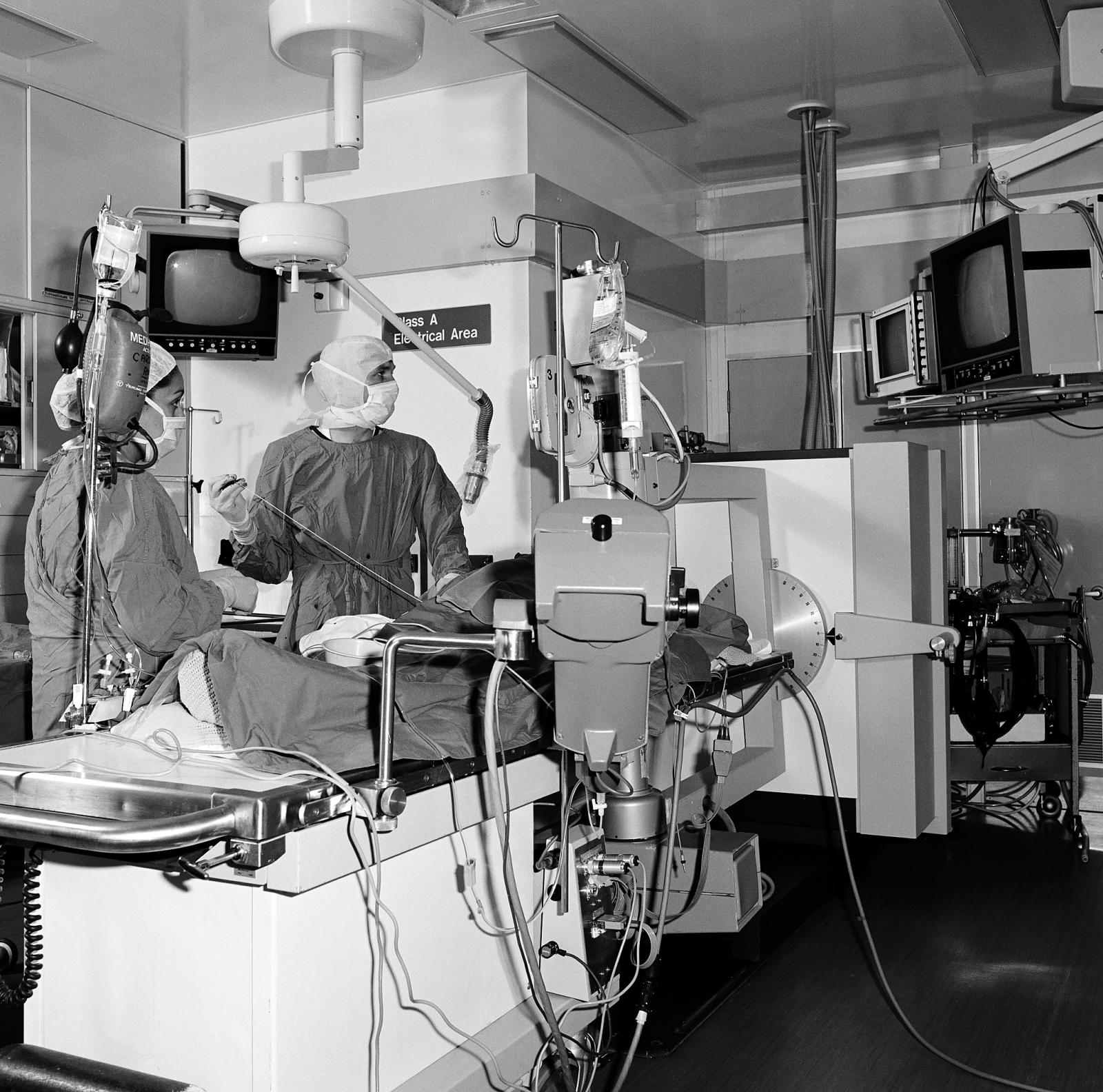RPH Museum
Royal Perth Hospital (RPH) pioneered advances in heart surgery in Western Australia from the 1950s.
Until the mid-20th Century major operations on the heart were unthinkable. Gas anaesthetic machines and new drugs and techniques made the more complex surgery possible.

Open heart surgery at RPH 1964
Early heart operations
A cardiology unit opened at RPH in 1953 to treat heart and blood vessel disorders.
In 1955 a surgical unit began to operate on the open heart. RPH doctors designed a heart-lung machine and made the parts. It was modified and improved by the hospital’s Instruments Department.
The ‘Melrose disc oxygenator’ took over the work of the heart and lungs. It provided blood and oxygen to the brain and body during the heart surgery.

Heart lung machine with Melrose disc oxygenator (black horizontal cylinder in the middle of machine on the right) 1963
Pacemakers and replacement heart valves
Advances in cardiology led to transplants and non-surgical procedures.
In 1959 the Medical Physics Department and doctors began to design and make pacemakers to regulate heartbeats.
The first transvenous pacemaker was implanted in 1965.
In the 1960s open-heart surgery to replace defective heart valves with mechanical or animal tissue became routine.

RPH Cardiac Unit 1963
The Heart Ambulance
In 1970 The West Australian newspaper reported that Margaret Wells was the first person in WA to be saved by an operation for a pulmonary embolism, a blood clot that stops blood flow to an artery in the lung.
Margaret was treated in the new intensive care heart ambulance on the way to RPH and then had surgery with the aid of the heart lung machine.

Intensive Care Ambulance c1969
A revolutionary approach to surgery
In the 1980s doctors used a tiny balloon to open blocked arteries in a procedure known as coronary angioplasty.
The first coronary stent in Australia was inserted at RPH in 1989. Heart valve transplants from human donors were performed at RPH in the same year.
By the 1990s stents became common and the number of open-heart coronary artery bypass surgeries began to fall. One of the world’s first 24-hour emergency angiography and angioplasty services opened allowing heart attack patients to be treated immediately and go home within 24 hours.
A cardiac gym opened in 1996. People with severe heart failure were rehabilitated by a physiotherapy team.

An RPH cardiologist inserts a catheter during a coronary angiography aided by closed-circuit x-ray 1983
Organ donation transfer
Before RPH had the capacity to perform heart and lung transplants, precious donated organs were sent to hospitals in the eastern states for transplantation.
“When we started the Organ Donor Program in 1991 surgeons would come from the eastern states in a charter plan to retrieve the organs. It was soon appreciated that we could send the hearts on a commercial flight. To manage this the police would be waiting for the surgery to finish to get my esky to the flight on time.” — Former RPH nurse Ailsa Allen

Blood cooling pump in RPH theatre for open-heart operation c1993
First heart transplant in Western Australia
In 1995 35-year-old Rod Western became the first WA patient to undergo heart transplant surgery. He had moved to Victoria to await a transplant but when the Perth unit opened, he came home to Esperance.
Patients accepted into the transplant program wore a pager. When Rod got the call, he was flown by Royal Flying Doctor Service to RPH.
“…I couldn’t get over how well these patients looked when they came back from theatre, and the next day they would be sitting up in bed. It was quite mind-blowing.” — Dr Geoffrey Clarke SOURCE: RPH and State Library of WA (SLWA) Oral History Project, transcript

WA's first heart transplant recipient, Rod Western, 1995
Heart-lung surgery
A team at RPH created medical history when they performed WA’s first heart-lung transplant in 2005.
The heart and lung transplant service pioneered video-assisted thoracic surgery in Perth, a type of surgery done inside the chest using a small camera and special instruments.

Heart-lung surgery at RPH c1998
Minimally invasive heart surgery
In the 21st century minimally invasive heart surgery was introduced. Surgeons operate on the heart by making small cuts and going between the ribs. Recovery is faster and less painful than open-heart surgery, with a lower risk of infection.
In 2009 a technique using 3D x-ray images in the operating theatre made it possible to replace heart valves in a shorter time and further reduce complications.
In 2014 the Cardiology Unit moved to Fiona Stanley Hospital.
“Royal Perth no longer does open heart surgery, which is a great pity. So much was learned from open heart surgery and dealing with cardiothoracic surgeons.” — Dr Geoffrey Clarke. SOURCE: RPH and SLWA Oral History Project